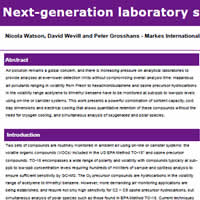Resumo do Pôster:
1. Introduction
Two sets of compounds are routinely monitored in ambient air using on-line or canister systems: the volatile organic compounds (VOCs) included in the US EPA Method TO-151 and ozone precursor compounds. TO-15 encompasses a wide range of polarity and volatility with compounds typically at sub-ppb to low-ppb concentration levels requiring hundreds of millilitres of sample and splitless analysis to ensure sufficient sensitivity by GC-MS. The ozone precursor compounds are hydrocarbons in the volatility range of acetylene to trimethyl benzene. However, more demanding air monitoring applications are being established, and require not only high sensitivity for C2 – C9 ozone precursor hydrocarbons, but simultaneous analysis of polar species such as those found in EPA Method TO-15. Current techniques that incorporate the two lists of compounds require liquid cryogen, firstly to remove water from the sample and secondly to cool the GC oven. This can lead to lengthy analysis times. This presents a challenge: is it possible to quantitatively analyse C2 hydrocarbons and polar species in a single analysis, without using liquid cryogen, while effectively managing the humidity that may be expected in ambient air? In this study, a cryogen free system that have been designed to allow canister samples with a wide range of analyte concentrations to be analyzed without the need for dilution is presented.
2. Purpose
Demonstrate the performance of a system to overcoming the challenges of simultaneous analysis of very volatile organic compounds (VVOCs) and oxygenated volatile organic compounds (OVOCs) in high humidity atmospheres.
3. Method
The samples of ozone precursor gas standards and TO-15 gas standards were all run with the conditions described in Table 1. Heated internal lines in the desorber and efficient purge steps combine to avoid the problem of carryover, even with the least volatile compounds of interest.
Table 1. Thermal desorption conditions |
Sampling volume |
Various at 20 mL/min |
Cold trap |
Universal trap (two-bed) |
Cold trap |
5 °C to 280 °C for 2 min |
Trap heating rate |
40 °C/s |
Line purge |
1 min at 50 L/min |
Trap purge |
Various at 20 mL/min |
Split ratio |
2:1 |
Flow path |
120 °C |
When designing a new method for monitoring the C2 compounds ethane, ethylene and acetylene, one of the first tests that should be performed is determining the maximum sample volume (i.e. breakthrough volume). Breakthrough volumes for C2 compounds are in the order of liters when employing a Nafion dryer and a trap temperature of -30 °C. However, the Nafion dryer removes some of the light polar compounds present in the TO-15 mix. In order to avoid collection of water on the trap, and without having to use cryogen to remove water, the best method is to employ a higher trap temperature. Breakthrough tests were carried out using a focusing trap temperature of 5 °C and the specifically designed ‘Universal’ trap. A linear relationship was observed for the majority of compounds up to and above 100 mL, but ethane and ethylene breakthrough at this level with the cold trap at this comparatively high trapping temperature. For further tests, the sample volume was kept below 50 mL and the trap temperature at 5 °C, to ensure efficient trapping of the C2 compounds whilst managing water. As detection limits of 0.2 ppbV for the combined list of compounds had to be reached2, and because of the small volume sampled, a very sensitive and selective mass spectrometer has to be used as detector.
4. Results and Discussion
The Instrument Detection Limits (IDLs) observed (Table 2) for a 45 mL sample volume of a 75% relative humidity standard are better than the required detection limits (0.2 ppbV)2.
Table 2. IDLs (ppbV) for a range of VOCs using a 45 mL sample |
Ethylene |
0.083 |
|
Propene |
0.049 |
|
Acrolein |
0.071 |
Acetylene |
0.040 |
|
Isobutane |
0.026 |
|
IPA |
0.017 |
Ethane |
0.060 |
|
Butane |
0.012 |
|
Pentane |
0.009 |
Chloromethane |
0.011 |
|
Ethanol |
0.061 |
|
n-Hexane |
0.010 |
Propane |
0.088 |
|
Isopentane |
0.020 |
|
Heptane |
0.013 |
Canister cleanliness is an important factor in determining IDL levels, and in line with the requirement to reach lower levels,2 changes to existing method require more stringent cleaning procedures and acceptance of cleanliness to be based on method performance.
5. Conclusion
This work shows how with small sample volumes, water is managed effectively with a cryogen free thermal desorber. The negligible carryover means that canister analysis can be confidently undertaken on samples of unknown concentration, facilitating automation and therefore increasing productivity. The thermal desorber presented is adept at handling compounds as volatile as ozone precursors without liquid cryogen coolant, due to the combination of trap dimensions, sorbent capacity and electrical cooling.
6. References
- Determination of Volatile Organic Compounds (VOCs) In Air Collected In Specially-Prepared Canisters And Analyzed By Gas Chromatography/Mass Spectrometry (GC/MS). METHOD TO-15 of the U.S. Environmental Protection Agency.
- New Jersey Department of Environmental Protection Site Remediation Program (NJDEP - SRP) Modified Low Level TO-15 Method, March 2007, March 2009 revision.
|

